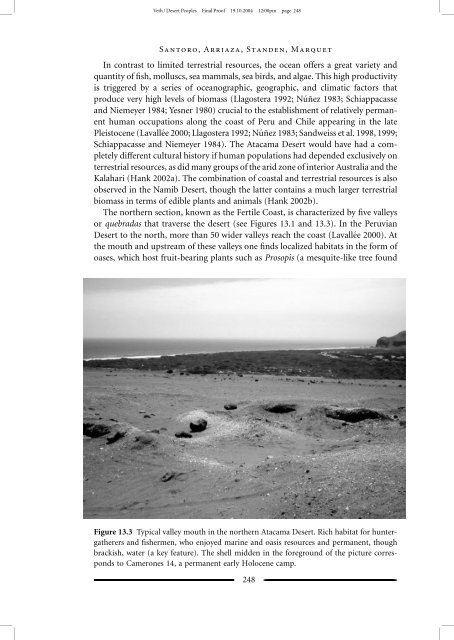Veth / <strong>Desert</strong> <strong>People</strong>s Final Pro<strong>of</strong> 19.10.2004 12:00pm page 248Santoro,Arriaza,Standen,MarquetIn contrast to limited terrestrial resources, <strong>the</strong> ocean <strong>of</strong>fers a great variety andquantity <strong>of</strong> fish, molluscs, sea mammals, sea birds, and algae. This high productivityis triggered by a series <strong>of</strong> oceanographic, geographic, and climatic factors thatproduce very high levels <strong>of</strong> biomass (Llagostera 1992; Núñez 1983; Schiappacasseand Niemeyer 1984; Yesner 1980) crucial to <strong>the</strong> establishment <strong>of</strong> relatively permanenthuman occupations along <strong>the</strong> coast <strong>of</strong> Peru and Chile appearing in <strong>the</strong> latePleistocene (Lavallée 2000; Llagostera 1992; Núñez 1983; Sandweiss et al. 1998, 1999;Schiappacasse and Niemeyer 1984). The <strong>Atacama</strong> <strong>Desert</strong> would have had a completelydifferent cultural history if human populations had depended exclusively onterrestrial resources, as did many groups <strong>of</strong> <strong>the</strong> arid zone <strong>of</strong> interior Australia and <strong>the</strong>Kalahari (Hank 2002a). The combination <strong>of</strong> coastal and terrestrial resources is alsoobserved in <strong>the</strong> Namib <strong>Desert</strong>, though <strong>the</strong> latter contains a much larger terrestrialbiomass in terms <strong>of</strong> edible plants and animals (Hank 2002b).The nor<strong>the</strong>rn section, known as <strong>the</strong> Fertile Coast, is characterized by five valleysor quebradas that traverse <strong>the</strong> desert (see Figures 13.1 and 13.3). In <strong>the</strong> Peruvian<strong>Desert</strong> to <strong>the</strong> north, more than 50 wider valleys reach <strong>the</strong> coast (Lavallée 2000). At<strong>the</strong> mouth and upstream <strong>of</strong> <strong>the</strong>se valleys one finds localized habitats in <strong>the</strong> form <strong>of</strong>oases, which host fruit-bearing plants such as Prosopis (a mesquite-like tree foundFigure 13.3 Typical valley mouth in <strong>the</strong> nor<strong>the</strong>rn <strong>Atacama</strong> <strong>Desert</strong>. Rich habitat for hunterga<strong>the</strong>rersand fishermen, who enjoyed marine and oasis resources and permanent, thoughbrackish, water (a key feature). The shell midden in <strong>the</strong> foreground <strong>of</strong> <strong>the</strong> picture correspondsto Camerones 14, a permanent early Holocene camp._ 248_
Veth / <strong>Desert</strong> <strong>People</strong>s Final Pro<strong>of</strong> 19.10.2004 12:01pm page 249<strong>People</strong> <strong>of</strong> <strong>the</strong> <strong>Coastal</strong> <strong>Atacama</strong> <strong>Desert</strong>in patches), small game (such as Ctenomys, a gopher-like fosorial animal), andcamelids (guanaco – Lama guanicoe), abundant sea birds, small quantities <strong>of</strong>freshwater fish and crayfish, roots <strong>of</strong> reed and tomatillo (Lycopersicon chilense),and potable water. <strong>People</strong> also appear to have moved upstream to look for lithicraw materials, a resource which is noticeably absent on <strong>the</strong> coast. Conditions in <strong>the</strong>terminal Pleistocene appear to have been more lacustral than today, with fluctuations<strong>of</strong> a magnitude that are seen to have had varying effects on human populations– an issue which is still under vigorous debate (Grosjean and Núñez 1994;Latorre et al. in press; Núñez et al. 2002; Usselmann et al. 1999).The central <strong>Atacama</strong> lacks <strong>the</strong> coastal oases, with fresh water restricted tobrackish springs. The landscape is essentially barren and vegetation is restrictedto lomas, <strong>the</strong> vegetation depending on <strong>the</strong> coastal fog which is reduced in extentalong <strong>the</strong> coast and <strong>the</strong> Pampa del Tamarugal. This is a large inland basinconnected to 15 to 20 quebradas, with Aroma, Tarapacá, Chacarilla, Guatacondo,and Maní being <strong>the</strong> most important (Luis Briones pers. comm.), and a series <strong>of</strong>salares (ancient dry lakes) located behind <strong>the</strong> <strong>Coastal</strong> Cordillera. These interiorbasins experienced wetter conditions by <strong>the</strong> end <strong>of</strong> <strong>the</strong> Pleistocene and alsopossibly <strong>the</strong> Holocene (Latorre et al. in press).The Peopling <strong>of</strong> <strong>the</strong> Region and Possible Migratory RoutesThree human migratory routes have been proposed for <strong>the</strong> colonization <strong>of</strong> thisdesert zone by <strong>the</strong> end <strong>of</strong> <strong>the</strong> Pleistocene, linked to colonists entering SouthAmerica through <strong>the</strong> Isthmus <strong>of</strong> Panama (ca. 13,000–12,000 bp). In <strong>the</strong> firstroute, people are argued to have moved from <strong>the</strong> Amazonian Basin to <strong>the</strong> coldterritories <strong>of</strong> <strong>the</strong> high Andes. On <strong>the</strong> coast <strong>of</strong> <strong>the</strong> <strong>Atacama</strong> <strong>Desert</strong> <strong>the</strong>se latePleistocene immigrants are argued to have become hunter-ga<strong>the</strong>rers and fishermen.Recent mitochondrial DNA analyses from late Holocene human remains <strong>of</strong><strong>the</strong> <strong>Atacama</strong> (ca. 4,000 bp) illustrate a strong genetic link with current tropicalforest populations (Moraga et al. 2002; Rivera and Rothhammer 1986, 1991). Thisdoes not necessarily mean, however, that all cultural traits found in <strong>the</strong> Pacific wereimported from <strong>the</strong> Amazon Basin.The second migratory route assumes that specialized hunter-ga<strong>the</strong>rers, withsophisticated lithic industries, colonized <strong>the</strong> Andes from nor<strong>the</strong>rn Colombia,next to <strong>the</strong> Isthmus <strong>of</strong> Panama (Rothhammer et al. 1984). According to Grosjeanand Núñez (1994), during <strong>the</strong> mid-Holocene a period <strong>of</strong> drought affected <strong>the</strong>highlands <strong>of</strong> <strong>the</strong> central <strong>Atacama</strong> <strong>Desert</strong>, causing <strong>the</strong> shrinking <strong>of</strong> lakes and <strong>the</strong>reduction <strong>of</strong> biotic resources with a subsequent loss <strong>of</strong> hunting opportunities (butsee Latorre et al. 2002; in press, for a different paleoecological perspective).Settlements are seen to have been abandoned, creating a silencio arqueológico(‘‘archaeological silence’’) as residential groups became more mobile or peopleconcentrated in local refuges or moved to <strong>the</strong> coast (Núñez 1983).Nei<strong>the</strong>r <strong>of</strong> <strong>the</strong>se two hypo<strong>the</strong>sized migratory scenarios is currently supported, asrecent archaeological data show that <strong>the</strong> first permanent settlements occurred_ 249_
















